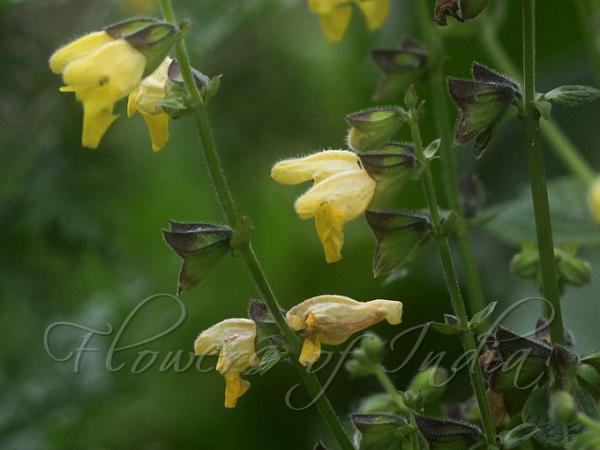|
| Bellflower Sage |
|

|

|
|
|
|
Photo: |
Botanical name: Salvia campanulata Family: Lamiaceae (Mint family)
Synonyms: Salvia codonantha
Synonyms: Salvia codonantha
Bellflower Sage is a perennial herb with stems erect,
43-80 cm, finely bristly or hairy. Flowers are borne in densely hairy,
glandular hairy 2-6-flowered whorls which are widely spaced, in
branch-end raceme-panicles; bracts ovate, 4-9 mm. Flowers are yellow,
about 2.7 cm, nearly hairless except upper lip hairy; tube hairy
annulate inside, gradually curved, dilated beyond hairy annulus, to 8
mm at throat; upper lip ovate, about 7 x 5 mm, slightly arcuate; lower
lip 1-1.2 × 1.2 cm, obliquely spreading; middle lobe
inverted-heart-shaped, about 4 x 8 mm, slightly constricted at base;
lateral lobes triangular-ovate, about 3 mm wide. Stamens are slightly
protruding or almost inside, filaments about 6.5 mm, style slightly
protruding. Flower-stalks are 2-5 mm. Sepal-cup is bell-shaped, about
1.3 cm, shallowly 2-cleft to strongly 2-lipped, hairy, glandular hairy,
sparsely black-brown glandular, margin ciliolate; upper lip broadly
ovate, about 3 × 10 mm, tip pointed; lower lip as long as upper, about
9 mm wide, tip with 2 triangular pointed teeth. Leaf-stalks are 3-25
cm; leaf blade heart-shaped to ovate-flat, 4-18 x 3.5-13.5 cm, below
hairy to velvet-hairy or densely hairy along veins, base heart-shaped
to flat, margin incised-rounded toothed, tip tapering. Bellflower Sage
is found in forest margins, forests, hillsides, valleys, at altitudes
of 800-3800 m, from the Himalayas to S. Central China. Flowering:
July-September.
| Identification credit: Ed Shaw | Photographed in Tawang distt., Arunachal Pradesh. |
• Is this flower misidentified? If yes,